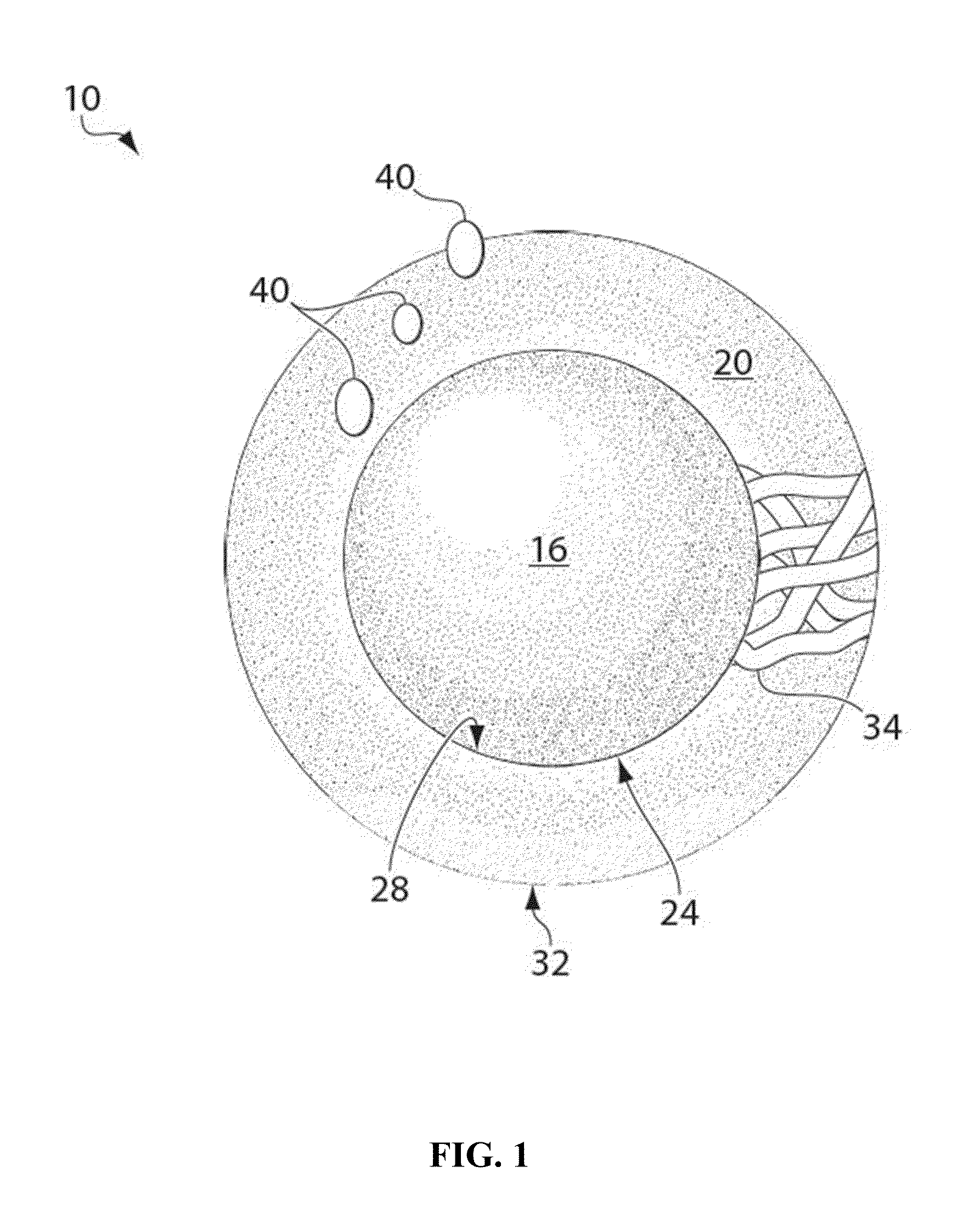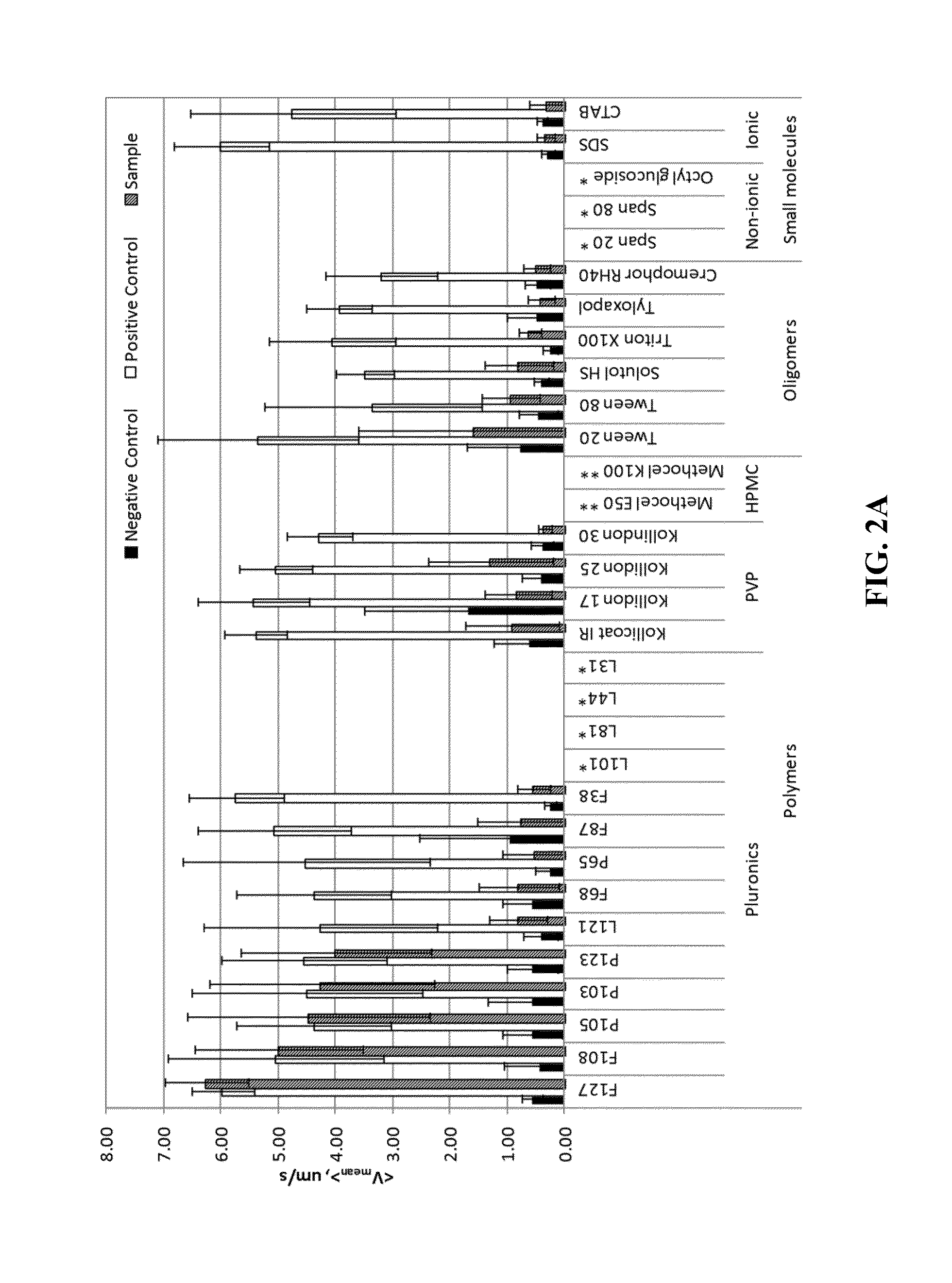Particles, compositions and methods for ophthalmic and/or other applications
- Summary
- Abstract
- Description
- Claims
- Application Information
AI Technical Summary
Benefits of technology
Problems solved by technology
Method used
Image
Examples
example 1
[0399]The following describes a non-limiting example of a method of forming non-polymeric solid particles into mucus-penetrating particles. Pyrene, a hydrophobic naturally fluorescent compound, was used as the core particle and was prepared by a milling process in the presence of various surface-altering agents. The surface-altering agents formed coatings around the core particles. Different surface-altering agents were evaluated to determine effectiveness of the coated particles in penetrating mucus.
[0400]Pyrene was milled in aqueous dispersions in the presence of various surface-altering agents to determine whether certain surface-altering agents can: 1) aid particle size reduction to several hundreds of nanometers and 2) physically (non-covalently) coat the surface of generated nanoparticles with a mucoinert coating that would minimize particle interactions with mucus constituents and prevent mucus adhesion. In these experiments, the surface-altering agents acted as a coating aro...
example 2
[0407]This example describes the formation of mucus-penetrating particles using various non-polymeric solid particles.
[0408]The technique described in Example 1 was applied to other non-polymeric solid particles to show the versatility of the approach. F127 was used as the surface-altering agent for coating a variety of active pharmaceuticals used as core particles. Sodium dodecyl sulfate (SDS) was chosen as a negative control so that each drug was compared to a similarly sized nanoparticle of the same compound. An aqueous dispersion containing the pharmaceutical agent and Pluronic® F127 or SDS was milled with milling media until particle size was reduced below 300 nm. Table 5 lists the particle sizes for a representative selection of drugs that were milled using this method.
TABLE 5Particle sizes for a representative selection of drugsmilled in the presence of SDS and F127.DrugStabilizerZ-Ave D (nm)PDIFluticasoneF1272030.114propionateSDS2020.193FurosemideF1272170.119SDS2000.146Itrac...
example 3
[0411]This example describes the formation of mucus-penetrating particles using a core comprising the drug loteprednol etabonate (LE).
[0412]In order to demonstrate the value of enhanced mucus penetration in the delivery of non-polymeric solid particles, an MPP formulation of loteprednol etabonate (LE MPP; LE particles coated with Pluronic® F127 made by the method described in Example 2) was compared to the currently marketed formulation, Lotemax®. Lotemax® is a steroid eye drop approved for the treatment of surface ocular inflammation. Conventional particles, such as those in Lotemax®, are extensively trapped by the peripheral rapidly-cleared mucus layer in the eye and, hence, are also rapidly cleared. LE MPPs are able to avoid adhesion to, and effectively penetrate through, mucus to facilitate sustained drug release directly to underlying tissues. Enhancing drug exposure at the target site would allow the overall dose to be reduced, increasing patient compliance and safety. In vivo...
PUM
| Property | Measurement | Unit |
|---|---|---|
| Length | aaaaa | aaaaa |
| Fraction | aaaaa | aaaaa |
| Fraction | aaaaa | aaaaa |
Abstract
Description
Claims
Application Information
 Login to View More
Login to View More - R&D
- Intellectual Property
- Life Sciences
- Materials
- Tech Scout
- Unparalleled Data Quality
- Higher Quality Content
- 60% Fewer Hallucinations
Browse by: Latest US Patents, China's latest patents, Technical Efficacy Thesaurus, Application Domain, Technology Topic, Popular Technical Reports.
© 2025 PatSnap. All rights reserved.Legal|Privacy policy|Modern Slavery Act Transparency Statement|Sitemap|About US| Contact US: help@patsnap.com



